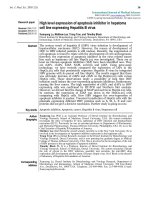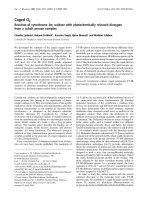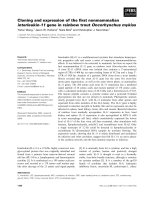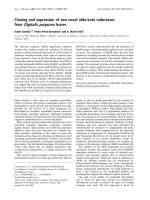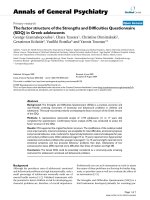Báo cáo y học: "High nuclear expression of STAT3 is associated with unfavorable prognosis in diffuse large B-cell lymphoma" doc
Bạn đang xem bản rút gọn của tài liệu. Xem và tải ngay bản đầy đủ của tài liệu tại đây (1.28 MB, 6 trang )
RAPID COMM U N I C A T ION Open Access
High nuclear expression of STAT3 is associated
with unfavorable prognosis in diffuse large B-cell
lymphoma
Wu ZL
1
, Song YQ
1
, Shi YF
2
and J Zhu
1*
Abstract
Background: The purpose of the study was to investigate the expression and prognostic value of STAT3 in diffuse
large B-cell lymphoma (DLBCL).
Methods: Seventy-four DLBCL patients from 2001 to 2007 were reviewed in the study. The STAT3 expression in
their tumor tissues was examined using the immunohistochemistry (IHC) method, and evaluated for its association
with clinicopathological parameters.
Results: Strong nuclear staining of STAT3 and phosphorylated-STAT3
tyr705
(P-STAT3) were observed in 19 cases
(25.7%) and 24 cases (32.4%), respectively, and the expression levels were highly consistent between them (P =
0.001). The high nuclear expression of STAT3 was more frequent in the non-germinal center B cell-like (non-GCB)
DLBCL than that in the GCB subtype, but not reaching significance (P < 0.061). The high nuclear expression of
STAT3 was found to be correlated with poor overall survival (OS) (P = 0.005). Multivariate Cox regression analysis
showed that the STAT3 expression was an independent prognostic factor for DLBCL patients regardless of CHOP or
R-CHOP regimen used as the first-line therapy.
Conclusion: STAT3 is more frequently expressed in non-GCB DLBCL than that in GCB subtype, and its strong
nuclear expression is correlated with poor OS in DLBCL.
Introduction
Diffuse large B-cell lymphoma (DLBCL) is defined by
the World Health Organization (WHO) Classification as
a heterogeneous entity, encompassing morphologic and
genetic variants, and variable clinical presentations and
outcomes [1]. It accounts for 80% of aggressive lympho-
mas [2]. International Prognostic Index (IPI) is currently
used to predict the prognosis i n DLBC [ 3], but its role
is limited[4]. Molecular subtypes of germinal center B
cell-like (GCB) and non-germinal center B cell-like
(non-GCB) DLBCL subtypes are pro posed to strati fy the
prognosis of DLBCL in addition to the IPI score [5-7],
but the application of Rituximab reduced the prognostic
difference between the two subtypes [8,9]. More prog-
nostic markers should be identified for DLBCL.
The Signal Transducers and Activators of Transcrip-
tion (STAT) family members play important roles in
transcriptional regulation and signal transduction, in
which STAT3 plays a critical role in regulation of cell
proliferation and survival [10] and is a critical transcrip-
tion activator in angiogenesis [11]. Hypermethylation
silencing of SOCS (the Suppressor of Cytokine Signal-
ing) genes leads to reactivation of STAT pathway,
resulting in the resistance to ABT-869, a pr omising
multi-targeted tyrosine kinase inhibitor [12]. STAT
pathway also triggers the activity of receptor-a ssociated
Janus kinase (JAK) family members and cross-talks with
the nuclear factor-B(NF-B) pathway, which is a n
important molecular pathogenesis of lymphoma [13].
Thus the STAT family has been actively studied as one
of molecular targets for anti-neoplastic therapy [14].
Expression of STAT3 in DLBCL subtypes may be vari-
able according to in vitro studies [15,16]. The cell line
studies showed that the activated B cell-like (ABC)
DLBCL had the highest level of STAT3 mRNA, roughly
* Correspondence:
1
Department of Lymphoma, Peking University School of Oncology, Beijing
Cancer Hospital & Institute; Key Laboratory of Carcinogenesis and
Translational Research (Ministry of Education); Beijing 100142, China
Full list of author information is available at the end of the article
ZL et al . Journal of Hematology & Oncology 2011, 4:31
/>JOURNAL OF HEMATOLOGY
& ONCOLOGY
© 2011 ZL et al; licensee BioMed Central Ltd. This is an Open Access article distributed under the terms of the Creative Commons
Attribution License ( which permits unrestricted use, distribution, and reproduction in
any medium, provid ed the original work is properly cited.
2-fold higher than that in the GCB DLBCL[15,16]. How-
ever, the STAT3 expression and its prognostic value in
different subtypes of DLBCL tumors were not inve sti-
gated. In the study, we investigated the expression level
and frequency of STAT3 in DLBCL tumors, the differ-
ence of STAT3 expression in different DLBCL subtypes,
and its prognostic value in DLBCL patients.
Materials and methods
Patients
Seventy-four consented patients with DLBCL in the
Beijing Cancer hospital from 2001-2007 were studied. In
58 patients, 27 cases were treat ed with R-CHOP and 31
cases with CHOP as first-line regimens. The clinical
research protocol was approved by our Institutional
Review Board (IRB). Archived formalin-fixed and paraf-
fin-embedded tumor tissues were obtained from our
Department of Pathology.
Immunohistochemical analysis (IHC)
4 μm thick sections were mounted on APES-coated
slides. After dewaxing in xylene and rehydrating in a
gradient concentration of ethanol, the slides were
immersed in methanol containing 0.3% hydrogen perox-
ide for 15 minutes to block endogenous peroxidase
activity. All slides were pretreated with an antigen
retrieval method by heating the slides in an autoclave in
citrate buffer (10 mM, pH 6.0) for 90 seconds except
those stained for P-STAT3. EDTA-Tris buffer (1 mM,
pH 9.0) was used for pretreating before P-STAT3 stain-
ing. After rinsing in TBS (pH7.6), the specimens were
incubated for 2 h at 37°C with anti-STAT3 antibody
(sc-7179 rabbit polyclonal antibody, Santa Cruz Bio tech-
nology) for STAT3, anti-P-STAT3 antibody (9145, rab-
bit monoclonal antibody, Cell Signaling Technology) for
P-STAT3
Tyr705
, and antibodies for BCL6, CD10, MUM-
1 (Santa Cruz Biotechnology). Subsequently, all slides
were incubated with Envision HRP antibody working
fluid (Dako Company) for 30 m inutes at 37°C, and then
developed with DAB-H
2
O
2
solution (Dako Company).
The cell nuclei were staine d with Meyer’ s hemotoxylin.
The normal tonsil tissue was used as a negative control
and breast c ancer tissue stained positive was used as a
positive control for STAT3 and P-STAT3 in all experi-
ments. For technical details, see the manufacturer’ s
instructions for each reagent.
IHC staining was evaluated by two independent
experienced pathologists, who were blinded to the clini-
cal data. As for the nuclear staining, at least 100 tumor
cells per specimen were counted and only specime ns
showing moderate to strong immunoreactivity were
considered positive. Staining wa s considered strong
positive when > 75% of tumor cell nuclei were stained
positive for S TAT3 and > 30% of tumor cell nuclei for
P-STAT3. Specimens stained positive for STAT3 ≤ 75%
and ≤ 30% for P-STAT3 were considered weak
immunoreactivity.
Statistics
The Chi-square test was used to analyze the consistence
of expressions of STAT3 in nucleus and P-S TAT3. Cor-
relation analysis of the STAT3 expression and the P-
STAT3 level with clinicopathological variables was per-
formed by two-sided Chi-square test. Kaplan-Meier
method was used to estimate difference of OS. OS was
defined as the time from diagnosis to death or the last
follow-up. The Cox regression model was used to evalu-
ate the prognostic value. The statistical software
SPSS16.0 was used for all the statistical analysis.
Results
Patient characteristics
All patients had complete follow-up information from
the Tumor Registry Office in our hospital. The clinico-
pathological characteristics are summarized in Table 1.
Fif ty five patients were younger than 60 years old. Male
and female patients were 30 and 44, separately. Twenty
nine patients were diagnosed with B symptoms, 50
patients had stage III-IV diseases and 50 patients were
diagnosed with the non-GCB subtype.
STAT3 expression
Among the 74 p atients, 66 cases (89. 19%) had the
STAT3 expression, including 19 cases (25.7%) with
strong nuclear staining of STAT3, and 24 cases (32.4%)
with strong nuclear staining of P-STAT3. Representative
staining outcomes were shown in Figure 1. There
existed a consistence between the STAT3 expression
and the P-STAT3 level (P = 0.001), indica ting the reli a-
bility and accuracy of our IHC analysis (Table 2).
Correlation between the nuclear expression of STAT3 and
clinicopathological parameters
We observed the associations of the STAT3 nuclear
expression with IPI score and molecular subtypes, but
no statistical signif icances were reached (P =0.099and
P = 0.061, respectively). No association was found
between the STAT3 nuclear expression and other fac-
tors, including B symptoms, age of onset, clinical stage,
and erythrocyte sedimentation rate ( ESR), lactate de hy-
drogenase (LDH), and tumor size (Table 1).
Association between the nuclear expression of STAT3 and
overall survival
Kaplan-Meier analysis showed that strong STAT3
nuclear expression was correlated with poorer OS (P =
0.005) (Figure 2). Other factors such as serum LDH
level, clinical stage, B symptoms, tumor size, and IPI
ZL et al . Journal of Hematology & Oncology 2011, 4:31
/>Page 2 of 6
score were also shown to be correlated with OS (data
notshown)asreportedinotherstudies,whichcon-
firmed our data is reliable. A forward stepwise multivari-
ate Cox model analysis, inco rporating the above factors,
demonstrated that the nuclear expression of STAT3 (P
= 0.001), LDH level (P = 0.002) and tumor size (P =
0.025) were independent prognostic factor for OS.
To analyze the prognostic implication of STAT3 in
term of Rituximab therapy, we stratified all patients into
two subgroups, the CHOP subgroup and the R-CHOP
subgroup. In CHOP subgroup, high nuclear expression
of STAT3 predicted poor survival (P =0.001).InR-
CHOP subgroup, 2 of 19 cases died of DLBCL in low
STAT3 cohort and 3 of 8 cases died in high STAT3
cohort. No sign ificant association was observed between
the expression of STAT3 and prognosis (P =0.216)in
the R-CHOP subgroup. But the survival curve showed
that high STAT3 expre ssion indicated poor OS in the
first 40 months. Thus, it needs to increase the sample
size to confirm this result (Table 3, Figure 3).
Discussion
Lam LT[15] et al. reported that activated B-cell diffuse
large B-cell lymphoma (ABC-DLBCL) had higher level
of STAT3 mRNA than that in GCB-DLBCL. Detection
with immunohistochemistry [15] showed that slightly
more cases with high nuclear expression of STAT3 were
observed in the non-GCB DLBCL group and the high
expression rates were 12.5% and 32.4% in GCB and
non-GCB subtypes, respectively. However, no statistical
significancewasfound.Thisismostlikelyduetothe
smal l sample size. Our study showed that the frequency
of high nuclear expression of STAT3 in DLBCL was
25.7% with 12.5% in GCB subgroup and 32% in non-
GCB subgroup, but not reaching significance (P =
0.061).
LamLTetal.[15]alsodemonstratedthathigh
STAT3expressioninABC-DLBCL patients correlated
with inferior overall survival, but not with GCB-DLBCL
patients. However, STAT3-high and STAT3-low subsets
within ABC-DLBCL did not differ in prediction of over-
all survival . Our study showed that high nuclear expres-
sion of STAT3 in DLBCL possibly correlated with poor
overall survival, especially in patients receiving CHOP
regimen. This poor outcome may be explained at least
in part by the multiple cellular functions of STAT3,
which is a critical component of diverse signal transduc-
tion pathways[15,17,18]. STAT3 regulates the expression
of a number of genes (e.g. survivin, bcl-xl, mcl-1) that
modulate cell survival, differentiation, and prolife ration
(e.g. c-myc, cyclin D1, p21, cyclin E), invasion and
metastasis (e.g. matrix metalloproteinase-9 and 2)[19],
and angiogenesis (e.g. vascular endothelial growth fac-
tor) [11,20,21]. STAT3 can restrain anti-tumour
immune responses [22-27] and regulate key cancer-pro-
moting inflammatory mediators, which can initiate or
promote oncogenic transformation, and genetic and epi-
genetic changes in malignant cells [28,29].
Our study also demonstrated the possibility of using
immunohistochemistry to detect STAT3 expression in
routine pathologic specimens, which may enable us con-
veniently to identify DLBCL cases with poor clinical
Table 1 Clinicopathological parameters and their correlations with STAT3 nuclear expression
Clinical Parameters No.# Nuclear Staining P Value Clinical Parameters No.# Nuclear Staining P Value
Low positive Strong positive Low positive Strong positive
Gender Stage
Male 30 20 10 0.165 I~II 24 18 6 0.582
Female 44 35 9 III~IV 50 37 13
Age IPI
< 60 55 43 12 0.161 0~2 48 39 9 0.099
≥ 60 19 12 7 3~4 22 14 8
B symptoms Bulky mass
positive 29 23 6 0.306 ≥ 10 cm 9 6 3 0.440
negative 45 32 13 < 10 cm 55 47 16
LDH Molecular subtypes
positive 28 19 9 0.235 GCB 24 21 3 0.061
negative 46 36 10 non-GCB 50 34 16
b2-MG Treatment regimens
positive 46 34 12 0.513 CHOP 31 22 9
negative 17 12 5 R-CHOP 27 19 8
ESR
positive 38 28 10 0.406
negative 29 23 6
ZL et al . Journal of Hematology & Oncology 2011, 4:31
/>Page 3 of 6
A B
C
D
E F
Figure 1 STAT3 expression and P-STAT3 level in DLBCL (A)
negative nuclear staining of STAT3, (B) negative nuclear
staining of P-STAT3, (C) weak nuclear staining of STAT3, (D)
weak nuclear staining of P-STAT3, (E) strong nuclear staining
of STAT3, (F) strong nuclear staining of P-STAT3.
Table 2 Relationship between the STAT3 expression and
the P-STAT3 level
STAT3 expression in
nucleus
Total P
Value
Weak
positive
Strong
positive
P-
STAT3
Low positive 43 7 50
Strong
positive
12 12 24 0.001
Total 55 19 74
Figure 2 Kaplan-Meier curve of overall survival (OS) using
STAT3 nuclear expression.
A
B
Figure 3 Kaplan-Meier curve of overall survival (OS) in patients
with different treatment regimens using STAT3 nuclear
expression. (A) Patients received the CHOP regimen; (B) Patients
received the R-CHOP regimen.
Table 3 Correlation of STAT3 nuclear expression with
overall survival
treatment STAT3 OS P
positive negative
CHOP Low 1 21 0.001
High 3 6
R-CHOP Low 2 17 0.216
High 3 5
ZL et al . Journal of Hematology & Oncology 2011, 4:31
/>Page 4 of 6
outcome, and subsequently guides us to ado pt more
intensive treatment for those patients.
Since STAT3 plays a critical role in tumor initiation
and progression, inhibition of STAT3 activation would
be an effective approach for cancer prevention and
treatment. Our findings may provide a basis for the
application of STAT3 inhibitors in the future.
Grant Support
ThisstudywassupportedbythegrantoftheNational
Science Foundation Committee (NSFC) of China (No.
30973484)
Acknowledgements
We would like to thank the personnel from the Pathology Diagnosis Unit of
Lymphoma at Peking University Health Science Center for their kind
assistance in the IHC staining; Dr. Fan Zhou in Department of Pathology &
Laboratory Medicine at Southwest Washington Medical Center, Vancouver,
for his kind help in English editing; and we thank Professor Wei Song in
Central Laboratory of Beijing Cancer Hospital for her kind help in the final
revision.
Author details
1
Department of Lymphoma, Peking University School of Oncology, Beijing
Cancer Hospital & Institute; Key Laboratory of Carcinogenesis and
Translational Research (Ministry of Education); Beijing 100142, China.
2
Department of Pathology, Peking University School of Oncology, Beijing
Cancer Hospital & Institute; Key Laboratory of Carcinogenesis and
Translational Research (Ministry of Education); Beijing 100142, China.
Authors’ contributions
ZJ designed the study and reviewed the final manuscript; WZL collected
and analyzed data, and drafted the manuscript; SYQ participated in the
study design and helped draft the manuscript and reviewed the final
manuscript; SYF helped the IHC staining. All authors read and approved the
final manuscript.
Conflicts of interests
The authors declare that they have no competing interests.
Received: 5 May 2011 Accepted: 1 August 2011
Published: 1 August 2011
References
1. Swerdlow SH, Campo E, Harris NL, Jaffe ES, Pileri SA, Stein H, Thiele J,
Vardiman JW, (Eds): World Health Organization Classification of Tumours of
Haematopoietic and Lymphoid Tissues, IARC Press, Lyon; 2008.
2. Harris N L, Jaffe ES, Stein H, Banks PM, Chan JK, Cleary ML, Delsol G, De
Wolf-Peeters C, Falini B, Gatter KC: A revised European-American
classification of lymphoid neoplasms: a proposal from the International
Lymphoma Study Group. Blood 1994, 84(5):1361-1392.
3. Sehn LH, Berry B, Chhanabhai M, Fitzgerald C, Gill K, Hoskins P, Klasa R,
Savage KJ, Shenkier T, Sutherland J, Gascoyne RD, Connors JM: The revised
International Prognostic Index (R-IPI) is a better predictor of outcome
than the standard IPI for patients with diffuse large B-cell lymphoma
treated with R-CHOP. Blood 2007, 109(5):1857-1861.
4. Talaulikar D, Shadbolt B, Dahlstrom JE, McDonald A: Routine use of ancillary
investigations in staging diffuse large B-cell lymphoma improves the
International Prognostic Index (IPI). J Hematol Oncol 2009, 22;2:49.
5. Alizadeh A A, Eisen MB, Davis RE, Ma C, Lossos IS, Rosenwald A, Boldrick JC,
Sabet H, Tran T, Yu X, Powell JI, Yang L, Marti GE, Moore T, Hudson J Jr,
Lu L, Lewis DB, Tibshirani R, Sherlock G, Chan WC, Greiner TC,
Weisenburger DD, Armitage JO, Warnke R, Levy R, Wilson W, Grever MR,
Byrd JC, Botstein D, Brown PO, Staudt LM: Distinct types of diffuse large
B-cell lymphoma identified by gene expression profiling. Nature 2000,
403:503-11.
6. Rosenwald A, Wright G, Chan WC, Connors JM, Campo E, Fisher RI,
Gascoyne RD, Muller-Hermelink HK, Smeland EB, Giltnane JM, Hurt EM,
Zhao H, Averett L, Yang L, Wilson WH, Jaffe ES, Simon R, Klausner RD,
Powell J, Duffey PL, Longo DL, Greiner TC, Weisenburger DD, Sanger WG,
Dave BJ, Lynch JC, Vose J, Armitage JO, Montserrat E, López-Guillermo A,
Grogan TM, Miller TP, LeBlanc M, Ott G, Kvaloy S, Delabie J, Holte H,
Krajci P, Stokke T, Staudt LM, Lymphoma/Leukemia Molecular Profiling
Project: The use of molecular profiling to predict survival after
chemotherapy for diffuse large-B-cell lymphoma. N Engl J Med 2002,
346(25):1937-47.
7. Wright G, Tan B, Rosenwald A, Hurt EH, Wiestner A, Staudt LM: Agene
expression-based method to diagnose clinically distinct subgroups of
diffuse large B cell lymphoma. Proc Natl Acad Sci USA 2003, 100(17):9991-6.
8. Pfreundschuh M, Trümper L, Osterborg A, Pettengell R, Trneny M, Imrie K,
Ma D, Gill D, Walewski J, Zinzani PL, Stahel R, Kvaloy S, Shpilberg O,
Jaeger U, Hansen M, Lehtinen T, López-Guillermo A, Corrado C, Scheliga A,
Milpied N, Mendila M, Rashford M, Kuhnt E, Loeffler M, MabThera
International Trial Group: CHOP-like chemotherapy plus rituximab versus
CHOP-like chemotherapy alone in young patients with good-prognosis
diffuse large-B-cell lymphoma: a randomised controlled trial by the
MabThera International Trial (MInT) Group. Lancet Oncol 2006, 7(5):379-91.
9. Sehn L H, Donaldson J, Chhanabhai M, Fitzgerald C, Gill K, Klasa R,
MacPherson N, O’Reilly S, Spinelli JJ, Sutherland J, Wilson KS, Gascoyne RD,
Connors JM: Introduction of combined CHOP plus rituximab therapy
dramatically improved outcome of diffuse large B-cell lymphoma in
British Columbia. J Clin Oncol 2005, 23(22):5027-33.
10. Calo’ V, Migliavacca M, Bazan V, Macaluso M, Buscemi M, Gebbia N,
Russo A: STAT proteins: from normal control of cellular events to
tumorigenesis. J Cell Physiol 2003, 197:157-168.
11. Chen Z, Han ZC: STAT3: a critical transcription activator in angiogenesis.
Med Res Rev 2008, 28(2):185-200.
12. Zhou Jianbiao, Goh Boon-Cher, Daniel HAlbert, Chen Shing Chien: ABT-869,
a promising multi-targeted tyrosine kinase inhibitor:from bench to
bedside. J Hematol Oncol 2009, 2:33-46.
13. Patrick BJohnston, Yuan RuiRong, Cavalli Franco, Thomas EWitzig: Targeted
therapy of lymphoma. J Hematol Oncol
2010, 3:45.
14.
Turkson
J: STAT proteins as novel targets for cancer drug discovery.
Expert Opin Ther Targets 2004, 8(5):409-22.
15. Lam LT, Wright G, Davis RE, Lenz G, Farinha P, Dang L, Chan JW, Rosenwald A,
Gascoyne RD, Staudt LM: Cooperative signaling through the signal
transducer and activator of transcription 3 and nuclear factor-B pathways
in subtypes of diffuse large B-cell lymphoma. Blood 2008, 111(7):3701-13.
16. Scuto A, Kujawski M, Kowolik C, Krymskaya L, Wang L, Weiss LM, Digiusto D,
Yu H, Forman S, Jove R: STAT3 Inhibition Is a Therapeutic Strategy for
ABC-like Diffuse Large B-Cell Lymphoma. Cancer Res 2011, 71(9):3182-8.
17. Ding BB, Yu JJ, Yu RY, Mendez LM, Shaknovich R, Zhang Y, Cattoretti G,
Ye BH: Constitutively activated STAT3 promotes cell proliferation and
survival in the activated B-cell subtype of diffuse large B-cell
lymphomas. Blood 2008, 111(3):1515-23.
18. Rane SG, Reddy EP: Janus kinases: components of multiple signaling
pathways. Oncogene 2000, 19(49):5662-79.
19. Dechow T N, Pedranzini L, Leitch A, Leslie K, Gerald WL, Linkov I,
Bromberg JF: Requirement of matrix metalloproteinase-9 for the
transformation of human mammary epithelial cells by Stat3-C. Proc Natl
Acad Sci USA 2004, 101(29):10602-7.
20. Baran-Marszak F, Boukhiar M, Harel S, Laguillier C, Roger C, Gressin R,
Martin A, Fagard R, Varin-Blank N, Ajchenbaum-Cymbalista F, Ledoux D:
Constitutive and B-cell receptor-induced activation of STAT3 are
important signaling pathways targeted by bortezomib in leukemic
mantle cell lymphoma. Haematologica 2010, 95(11):1865-72.
21. Niu Guilian, Kenneth LWright: Constitutive Stat3 activity up-regulates
VEGF expression and tumor angiogenesis. Oncogene 2002, 21:2000-2008.
22. Kujawski M, Kortylewski M, Lee H, Herrmann A, Kay H, Yu H: Stat3 mediates
myeloid cell dependent tumor angiogenesis in mice. J Clin Invest 2008,
118:3367-3377.
23. Kortylewski M, Xin H, Kujawski M, Lee H, Liu Y, Harris T, Drake C, Pardoll D,
Yu H: Regulation of the IL-23 and IL-12 balance by Stat3 signaling the
tumor microenvironment. Cancer Cell 2009, 15:114-123.
24. Wang L, Yi T, Kortylewski M, Pardoll D, Zeng D, Yu H: IL-17 can promote
tumor growth through an IL-6/Stat3 signaling pathway. J Exp Med 2009,
206:1457-1464.
ZL et al . Journal of Hematology & Oncology 2011, 4:31
/>Page 5 of 6
25. Cheng F, Wang HW, Cuenca A, Huang M, Ghansah T, Brayer J, Kerr WG,
Takeda K, Akira S, Schoenberger SP, Yu H, Jove R, Sotomayor EM: A critical
role for Stat3 signaling in immune tolerance. Immunity 2003, 19:425-436.
26. Yu H, Kortylewski M, Pardoll D: Crosstalk between cancer and immune
cells: role of STAT3 in the tumour microenvironment. Nature Rev
Immunol 2007, 7:41-51.
27. Yin Q, Zha X, Yang L, Chen S, Zhou Y, Wu X, Li Y: Generation of diffuse
large B cell lymphoma-associated antigen-specific Vα6/Vβ13+T cells by
TCR gene transfer. J Hematol Oncol 2011, 4:2-9.
28. Haura E B, Turkson J, Jove R: Mechanisms of disease: insights into the
emerging role of signal transducers and activators of transcription in
cancer. Nature Clin Pract Oncol 2005, 2:315-324.
29. Mantovani A, Allavena P, Sica A, Balkwill F: Cancer-related inflammation.
Nature 2008, 454:436-444.
doi:10.1186/1756-8722-4-31
Cite this article as: ZL et al.: High nuclear expression of STAT3 is
associated with unfavorable prognosis in diffuse large B-cell lymphoma.
Journal of Hematology & Oncology 2011 4:31.
Submit your next manuscript to BioMed Central
and take full advantage of:
• Convenient online submission
• Thorough peer review
• No space constraints or color figure charges
• Immediate publication on acceptance
• Inclusion in PubMed, CAS, Scopus and Google Scholar
• Research which is freely available for redistribution
Submit your manuscript at
www.biomedcentral.com/submit
ZL et al . Journal of Hematology & Oncology 2011, 4:31
/>Page 6 of 6
